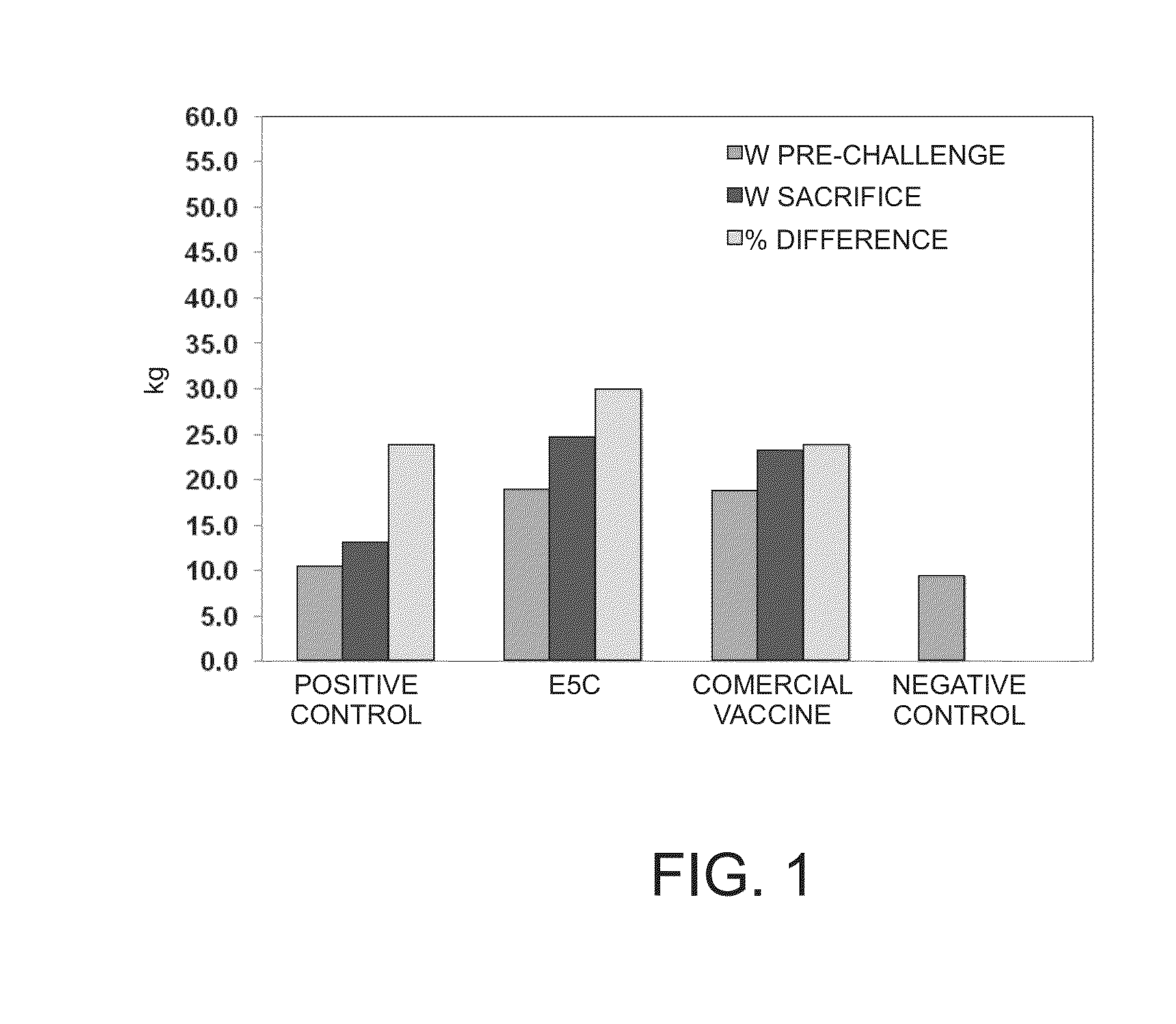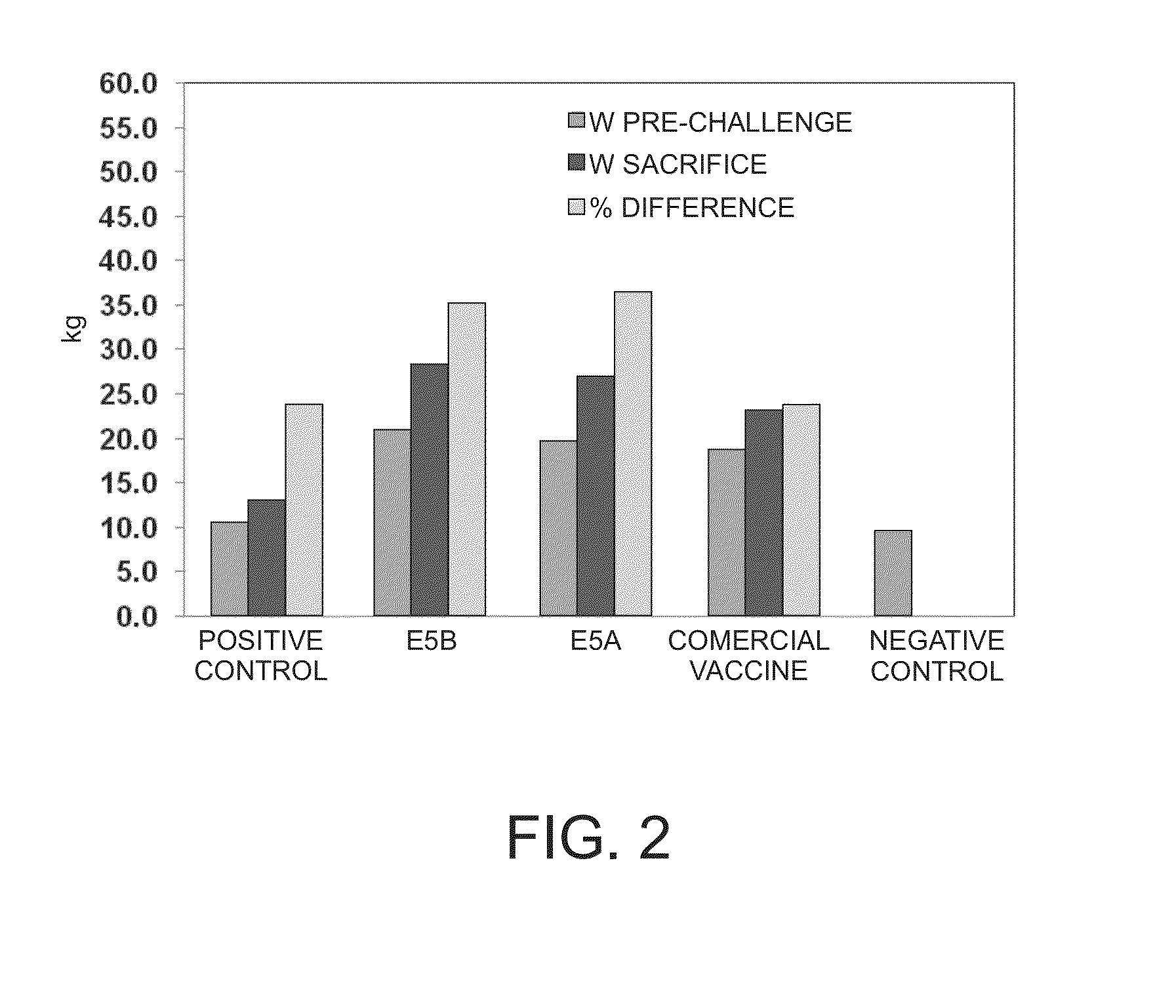Recombinant vaccine against prrs in a viral vector
a viral vector and recombinant technology, applied in the field of porcine reproductive and respiratory syndrome prevention and control, can solve the problems of difficult to use the traditional method based on various vaccination strategies to combat, disease development and immunological damage, and the ineffective prevention of live attenuated vaccines, etc., and achieve the effect of quick replication
- Summary
- Abstract
- Description
- Claims
- Application Information
AI Technical Summary
Benefits of technology
Problems solved by technology
Method used
Image
Examples
example 1
Production of the Newcastle LaSota Vector
[0029]In order to clone the genome of the Newcastle virus, strain LaSota, and thus generate a viral vector, firstly, an intermediate vector was created, called “pSL1180NDV / LS”. To this end, total viral RNA extraction of Newcastle strain LaSota was carried out by the triazole method. From the purified RNA, the synthesis of cDNA (complementary DNA) of the viral genome was performed, using the total RNA previously purified as a template. With the purpose of cloning all the genes from the Newcastle genome (15, 183 base pairs (bp)), 7 fragments with “overlapping” ends and cohesive restriction sites were amplified by PCR. Fragment 1 (F1) covers nucleotides (nt) 1-1755, F2 goes from nt 1-3321, F3 comprises from nt 1755-6580, F4 goes from 6,151-10, 210, F5 includes from nt 7,381-11,351, F6 goes from 11,351-14,995 and F7 comprises from nt 14,701-15,186. The assembly of the 7 fragments was made inside a cloning vector called pGEM-pSL1180 using linking ...
example 2
Cloning of the ORF 5 and ORF 6 Genes from vPRRS
[0030]To clone the ORF 5 and ORF 6 genes from vPRRS, total viral RNA extraction was carried out by the Triazole method. This purified total RNA was then used to synthesize the cDNA (complementary DNA), and by the PCR technique, said genes from PRRS virus were amplified using specific oligonucleotides. ORF 5 and ORF 6 genes were inserted later in the fermentas pJET vector using cloning standard techniques, thus obtaining the plasmid: pJETORF5 / ORF6.
example 3
Cloning of the ORF 5 and ORF 6 Genes from vPRRS within SacII Site of pSL1180 NDV / LS Vector to Produce Plasmid pNDV-LS(wt)Orf5 / 6
[0031]A: Production of the pIntNhe Intermediate Vector
[0032]With the purpose of introducing the transcription sequences from Newcastle called GE / GS in the 5′ end of ORF 5 and ORF 6 genes, a new intermediate vector was built, called pintNhe, by the PCR initial amplification of the GE / GS sequences, taking the Newcastle genome as a template, and the later insertion of these sequences in pGEM-T.
B: Subcloning of the ORF 5 and ORF 6 Genes to Vector pIntNhe
[0033]The pIntNhe plasmid was digested with SpeI-HpaI and then cloned into the pIntNhe, obtaining the pint Nhe 56 plasmid.
[0034]C: Subcloning of GE / GS-ORF5 / 6 to Vector pSL1180NDV / LS
[0035]The pINTNhe 56 plasmid was digested with NheI enzyme and the PSL1180 NDV / LS plasmid was digested with SacII; digestion products were shaved off in order to leave compatible linking sites, and the GE / GS-ORF5 / 6 region was purified ...
PUM
| Property | Measurement | Unit |
|---|---|---|
| size | aaaaa | aaaaa |
| time | aaaaa | aaaaa |
| time | aaaaa | aaaaa |
Abstract
Description
Claims
Application Information
 Login to View More
Login to View More - R&D
- Intellectual Property
- Life Sciences
- Materials
- Tech Scout
- Unparalleled Data Quality
- Higher Quality Content
- 60% Fewer Hallucinations
Browse by: Latest US Patents, China's latest patents, Technical Efficacy Thesaurus, Application Domain, Technology Topic, Popular Technical Reports.
© 2025 PatSnap. All rights reserved.Legal|Privacy policy|Modern Slavery Act Transparency Statement|Sitemap|About US| Contact US: help@patsnap.com


